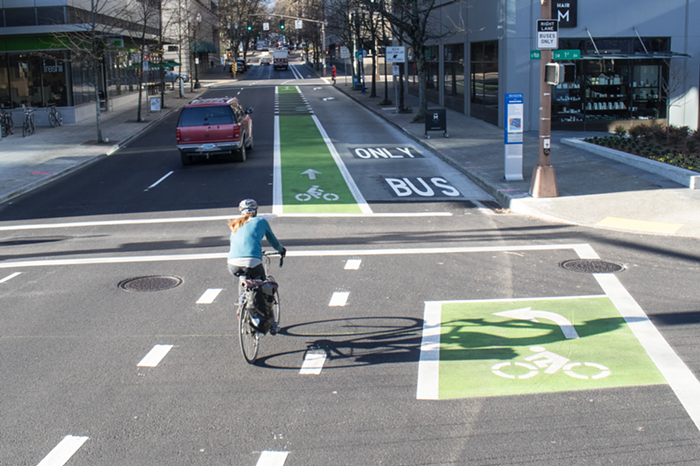PORTLAND IS KNOWN for being well planned—but none of the fluffy feelings we have about our city would matter if it didn't have a decent street grid. Portland's streets are mostly a very regular collection of north-south and east-west coordinates. No cul-de-sacs, no weird patterns—just an easy grid. Well, mostly. I was fortunate enough to talk with Portland State University's Carl Abbott, author of Portland in Three Centuries, about the history of Portland's streets, address system, and why there are occasionally maddening exceptions like Sandy Boulevard that screw up what is otherwise a very nice grid.
___________________________________________________________
In the Beginning, There Were Teeny-Tiny Blocks
Portland's blocks are minuscule. In the central Westside area, they measure a mere 200 by 200 feet. Portland lacks the long, hulking blocks of East Coast cities, and that's generally a good thing. No less than Jane Jacobs, one of the most well-known figures in modern urban planning, devoted a whole chapter to them in her classic The Death and Life of Great American Cities.
The small blocks allow for a great deal of flow for pedestrians, bikes, and other traffic. However, this feature didn't come about because Portland's founders were forward-thinking citymakers. No, the smallness of the blocks happened because of good old-fashioned real estate speculation.
When Portland was originally settled in the 1840s, city founders like Francis Pettygrove and Asa Lovejoy weren't necessarily looking to create a well-functioning urban center. They wanted to make a big pile of cash. Lots with the potential for higher foot traffic sold for more, and corner lots experienced more traffic than areas in the middle of the block. Portland's early speculators divvied up land into small blocks so it would contain more high-priced corner lots. The present system is great for getting around, but its origins lie in avarice, not altruism.
_________________________________________________________________________________________
Great Renaming of 1891 and Even Greater Renumbering of 1931
Before 1891, the area east of the Willamette River was not Portland. It was a separate town, creatively called East Portland. Where the Albina neighborhood is today, there was another town called Albina. Bent on becoming a Big Important City, Portland decided to instantly increase in size by eating the nearby municipalities. "Portland wanted to count the East Portland and Albina population," says Abbott, "so that when people compared its population to Seattle's, Portland's would still be higher. It was very much a promotion and image-making reason." Albina and East Portland saw some service upgrades when they became part of the big city, but it was mostly all about size mattering.
The newly huge Portland had a number of redundancies. For instance, there were multiple streets named after letters or trees. It would not do to have more than one Pine Street in Portland, especially if those streets were on different sides of the river. In 1891, Portland renamed several streets, mostly to eliminate duplicate names.
Curiously, it doesn't seem like many people complained about this. Abbott's assessment of the renaming was that people thought it was a fairly logical thing to do, and when I asked the city archives if they could find any angry letters to the mayor or city council about the project, they came up empty. It seems that hardly anyone in 1891 got too worked up about several streets changing names all at once.
That wasn't the end of it, though. Even though the street names were all in order, the newly coagulated Portland still had a mess of an address system. The addresses (as well as any street suffixes or prefixes that said "NE" or "SE") reflected the systems set up by three different municipalities—Portland, East Portland, and Albina. Starting in the 1920s, city planners embarked on a comprehensive plan to bring some sense to the city's addresses. In 1931, Portland was split into the five "quadrants" we have today, with address numbers counting up from either the Willamette River or Burnside. The city provided complimentary address numbers to everyone in Portland who had to switch out the numerals on their buildings, and we still use that system of X/Y coordinates today. (This has led to some curious numbering, though. Go to the John's Landing area, and you'll see addresses that start with zero. Their location is in a kind of negative space, outside the boundaries of the 1931 grid.)
Again, this was not too controversial when it happened. At the City Archives, I'd hoped to find angry letters to the city complaining about the change. It seems, though, that everyone went along with it. Abbott couldn't recall any controversy either, and said that the only people who really raised a stink were the postal workers, who'd taken the time to learn the old, convoluted address system.
To this day, though, you can sometimes find old, seemingly erroneous street names and address numbers pressed into concrete, relics of names and numbers that used to be.
_________________________________________________________________________________________
Those Triangular Blocks South of Burnside
The area south of West Burnside was the original center of Portland. After initial settlement, Captain John Couch staked a claim slightly north of the center of town. There's a popular story that the reason for the change in street direction at Burnside was that the surveyors in what would become Southwest Portland used a compass when laying out their north/south streets, but Captain Couch, being a more exacting sailor, used the pole star. The break, then, and the reason for the triangular blocks near Burnside, comes from the meeting of streets that pointed to old magnetic north, but then shifted to true north.
Sadly, this colorful story is probably just that: a story. Neither Abbott nor the helpful staff at the City of Portland Archives could confirm it for me, and when I inquired as to why the streets shift, both said that it was because they were built parallel to the river. That creates something of a ripple effect, and blocks some distance away have irregular shapes. Speaking of Captain Couch, though...
_________________________________________________________________________________________
Ankeny, Burnside, Couch, Davis...
John Couch is the reason for Northwest's nicely alphabetized streets. He originally named them A, B, C, D, etc. After Couch's death in 1870, his streets were renamed, with various Portland founders assigned to the corresponding letters.
_________________________________________________________________________________________
Sandy Boulevard and Disruptive Diagonals
Sandy Boulevard is a loathsome diagonal which mars the perfection of Portland's Eastside grid like a deep scratch through a wooden chessboard. To a lesser extent, Foster and Powell also spoil the coordinate plane of deep Southeast. Why on earth would city planners give us the headache of these nonconforming eyesores? The short answer is they didn't.
Both Sandy and Foster predate Portland's grid system. "There are a couple of diagonal streets," says Abbott, "which cut right through the grid. Those were old trails. Sandy Boulevard led down from the Columbia River... cutting the shortest path before there was any grid at all. The grid just wrapped around that." Getting rid of those streets would have meant getting rid of existing infrastructure that had sprung up along informal trails.
_________________________________________________________________________________________
Laurelhurst, the Suburb in the City
The streets of the Laurelhurst neighborhood curve, rise, and drop unlike any other part of town, excepting the West Hills. The regular, navigable streets around it suddenly bend into something that resembles a suburb or subdivision, and there's a good reason for that.
"It's similar to a lot of upscale suburbs or subdivisions that people developed in the late 19th and early 20th century," says Abbott. "It was a style of planning that said 'this isn't just a standard grid where anyone can live...' It's a status maker." Eastmoreland's planning is very similar.
Those are not the only class markers in the grid, though. In NW Portland the blocks often stretch out on a west-east axis, extending much longer than their 200-by-200-foot brethren. When Captain John Couch was parceling out that land, he had ambitions of building large mansions with big lawns on what was then the edge of town. These small snags in the grid are areas where class, before anyone even actually moved in, divided one part of Portland from another.
_________________________________________________________________________________________
Ladd's Addition
Nestled in SE Portland, there is a den of madness. Streets curve and end suddenly. Roads that you thought led out of the maze only lead back to the center.
Ladd's Addition, despite being filled with lots of pretty trees and flowers, is a pain to navigate. The culprit responsible for the (albeit beautiful) mess is William Ladd, the two-time mayor of Portland in the 1850s. After his term as mayor, Ladd was still a prominent businessman, and owned a fair amount of land. Ladd didn't split up his land like other developers did, though. He wanted his part of Portland to be a special snowflake, and set out to make an area wholly unlike the rest of the city, or, for that matter, anywhere.
Superficially, Ladd's Addition resembles much of Washington, DC, where streets radiate out from central squares. DC, in turn, is reminiscent of a good deal of European cities. However, the layout of Ladd's Addition is unique to Portland.
Abbott again: "It's not possible to find a specific model that he was imitating. It's unique to Portland... [with] the circle in the middle with streets radiating out at odd angles, interrupting it." So, even though that part of town is a confusing whirlpool of uncertainty, at least it's our own, unique confusing whirlpool of uncertainty.














